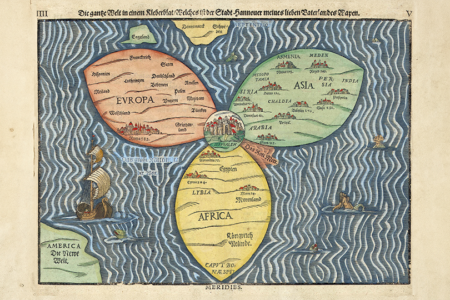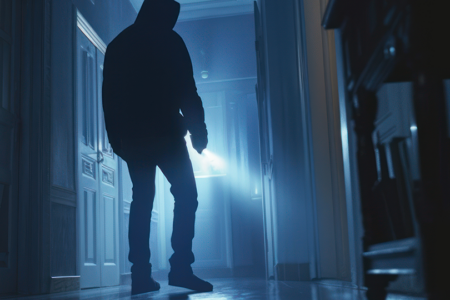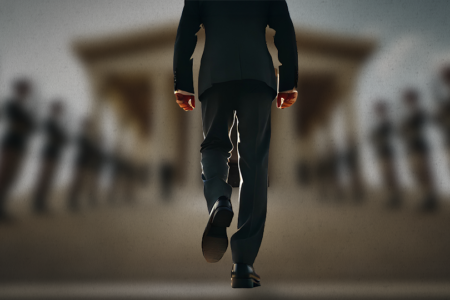Would God it were Morning
“And the Lord shall scatter you (Israel) among all people, from one end of the earth even unto the other; and there shall you serve other gods, which neither you nor fathers have known, even wood and stone. And among these nations (Gentiles) shall you find no ease, neither shall the sole of your foot have rest; but the Lord shall give you a trembling heart, and failing of eyes, and sorrow of mind. And your life shall hang in doubt before you; and you shall fear day and night, and shall have no assurance of your life: In the morning you shall say, ‘Would God it were evening!’ And at evening you shall say ‘Would God it were morning!’ for the fear of your heart wherewith you shall fear, and for the sight of your eyes which you shall see” (Deuteronomy 28:64-67).
This grim prophecy concerning God’s chosen people was penned by Moses in the Torah over 3000 years ago. It pictures Israel as scattered and suffering. That the first part of this prophecy has been fulfilled is plainly evident from demographic statistics of the Jewish people. Scarcely a major nation in the world has been without a substantial Jewish population during this present century. Jews of the Diaspora still outnumber those living in the Promised Land, as they have during the past 1,900 years.
The concern of this article is with the second and most emphatic part of the prophecy, that which speaks of suffering. Moses described a very intense and prolonged agony. “No ease … no rest . . . trembling heart. . . failing of eyes . . . sorrow of mind . . . fear day and night” are the words he used to describe the future experience of his people. A climax was reached in the fear-ridden plea that time would swiftly pass by, ” Would God it were morning! ” Are these words to be interpreted as exaggerations or hyperbole? It is the contention of this paper that Jewish history demands a literal understanding of the second part of Moses’ prophecy, even as it does the first. Consider the long night of Jewish despair.
I. The Lengthening Shadows
Although the Bible records several attacks upon the political institutions of Israel, the first serious hostility toward Jews because of their cultural distinctives was in the 2nd century B.C. The Greek rulers who succeeded Alexander the Great were unable to maintain the political unity of his vast empire. They did, however, keep alive his dream of unity among all civilized people based on a common language (Greek) and culture (Hellenic). The remains of Greek temples, stadiums and amphitheaters scattered throughout the ancient Middle East bear witness to the Pan Hellenic dream. Greek gods and goddesses were readily identified with their counterparts among non-Greeks. Only in the Jewish community did the Greek rulers meet stubborn resistance to the program of Hellenic unity. The descendants of Abraham alone refused to identify Jehovah with Zeus or to open their temple for sacrifices by strangers to other gods. The issue was joined in 175 B.C. when Antiochus IV (Epiphanes) ascended the Seleucid throne. When manipulation of the high priesthood failed to bring the desired conformity, the king resorted to imperial edicts designed to eliminate distinctive Jewish practices. Circumcision and Sabbath observance were banned and the Jewish temple was forced to allow pagan sacrifices. The gauntlet was laid down; the Jew must conform or die. He was being introduced to a lesson which was to be repeated many times during the growing darkness of his night — that as a human he had many rights, but as a Jew, none. This initial confrontation brought successful Jewish resistance, the Maccabean Revolt. What started as a protest against the loss of religious and cultural freedom ended as a successful quest for political independence. The Maccabean fighter discovered what the long night of Jewish anguish would illustrate — there is no Jewish freedom without Jewish autonomy.
During the Roman period the shadows continued to lengthen. Commitment to monotheism would not permit the Jew to worship other gods and the emperor. This brought censure from several of the caesars and occasional expulsions. Even in the fourth century, when Constantine virtually made Christianity the official religion of the empire, Jews suffered discrimination. They were denied high public office and rabbinical jurisdiction over personal matters. Israel’s ancestral land was now looked upon as holy to the Christian rather than to the Jew. Through allegorical interpretation, Old Testament promises were stripped from Israel and conferred in spiritual form upon the Church.
The flight of Mohammed from Mecca to Medina in 622 A.D. changed the face of the Middle East and North Africa almost overnight. Within a century the sword brandishing fanatical followers of Allah’s prophet conquered the lands from Persia to southern France. Great numbers of Jewish folk suddenly found themselves living under Moslem rule. Although pagans were forced to submit to Islam, Jews and Christians were not. Since Mohammed had built his monotheistic faith in part on biblical revelation, both Jews and Christians received special consideration as “People of the Book . Both groups, however, were required to pay heavy tribute, wear distinctive dress, and live in separate quarters in the village. Other than these restrictions, Jews were able to participate fully in the political and economic life of the community. The Jews in Spain fared significantly better under Moslem control than when they later were under Christian rule.
II. Twilight
The watershed of anti-Semitism occurred in 1095 when Pope Urban II cailed for the First Crusade. Prior to this, discrimination against the Jewish community was sporadic and relatively mild. With the new era of the Crusades, hostility against Jews became vicious and violent. Mobs of ignorant and superstitious men Joined the Crusader army in quest of adventure, liquidation of debts and assurance of heaven. Such troops were easily incited by fanatics who labeled all Jews “Christ killers,” “Children of Satan” and “Enemies of the Cross”. As the armies made their way across Europe, Jewish homes and villages were pillaged and destroyed. In Germany as many as 12,000 died in the space of three months. When the First Crusade reached Jerusalem in 1099, all of the Jews in the city were herded into a synagogue and burned alive. The long twilight of Jewish agony had begun.
For the next 700 years the European Jewish community was to suffer a variety of psychological indignities and physical afflictions. Natural disasters such as the Black Death (1348-1350) were interpreted as divine judgment upon Israel. Ignorant masses were easily persuaded to believe that Jews kidnapped Christian children, slaughtered them and used their blood in the Passover observance. The decision of the 4th Lateran Council in 1215, under the influence of Pope Innocent III, to dogmatize the belief in transubstantiation led to the popular belief that Jews desecrated the host (wafer in communion) by stomping on it until it bled and cried out. Although many church leaders spoke out against such charges, a superstitious age made it easy for such rumors to spread and innocent folk to be hurt.
During this time, Jews were denied public office and in some areas stripped of their lands. Landless Jews were forced into merchant and banker roles where they soon excelled. Increased wealth stimulated further suspicion, pillaging and confiscation. Jews were required to wear a special badge to discourage social intercourse. Jewish women were sometimes ordered to attach bells to their dresses so they could be heard approaching. In England the badge resembled the tablets of the Law while elsewhere a cone-shaped cap was the distinguishing mark. Whatever the design, the effect was the same. Jews were singled out as undesirable people. They were to be shunned, spit upon, cursed and sometimes physically abused.
The first ghetto appeared in Venice in 1516. When institutionalized later, it was completely cut off from the rest of the city by a wall and gate. Overcrowded conditions were common and curfew hours strictly maintained by Gentile gatekeepers, whose wages were to be paid by the Jewish occupants.
Sporadically during this period attempts were made to force Jews to convert to Christianity. The primary too! in this effort was the Inquisition, sponsored by the pope and directed at all defined as heretics. Failing in the attempt to convert Jews, several countries expelled them. Jews were expelled from England in 1290, in spite of the Magna Charter which had been signed in 1215. In France Jews were ordered to leave in 1306 and again in 1394. All non-converted Jews were banished from Spain in 1492 and from Portugal, Sicily and Sardinia five years later. The expulsions from Spain and Portugal alone accounted for more than 100,000 Jews. The suffering involved is sensed when it is realized that they had no certain haven at the end of their journey nor any protection while traveling. Highway thieves, rapists and murderers made sport of the fleeing Jews. It is ironic that the year of Jewish expulsion from Spain marked also the opening of the New World by Columbus. It might be expected that the newly discovered areas would provide a refuge for the rejected Jew. Unfortunately, the same government which expelled him from the mainland denied him residence in the new possessions. It was not until the Dutch established a settlement in Brazil and later in New Amsterdam (New York) that Jewish pioneers were able to enter the New World.
With the Protestant Reformation of the 16th century, and the American and French Revolutions of the 18th century, came the promise of a new social order rooted in individual freedom and justice for all. Jewish hopes soared in the conviction that the long night of suffering was over and the day for which they prayed was here. At long last the Jew was free to be, above all things, a Jew.
Or was he?
Although significant strides were made in the cause of human rights during the 18th and 19th centuries, the benefits to the Jew were more apparent than real. While it is true that he no longer had to wear the badge nor live in the ghetto, he was still the object of quiet suspicion, scorn and discrimination. Even the low profile which anti-Semitism wore in those days was not to last. The mounting tide of nationalism, which transformed the map of Europe, branded the Jew a foreigner, an unwelcome stranger. He had no certain home in a polarizing Gentile world. The hopes for daybreak were premature. The night of Israel’s agony continued.
In France it took the miscarriage of justice in but one single case to unveil the vicious anti-Semitism which lurked just beneath the surface. Although clearly innocent, twelve years were consumed in litigation and imprisonment before Captain Alfred Drefus, the first Jewish officer to be on the French general staff, was exonerated. Vicious hatred for the Jews was evident during the proceedings when the Parisian crowds demanded, “Kill the Jew.” It was this open hostility which destroyed the illusion held by a young Jewish journalist from Vienna, Theodore Herzl, that European Jewry should be assimilated. It was when Herzl reflected on what he saw and heard that he wrote Der Judenstadt, in which he dreamed of a sovereign Jewish state as the only solution to the Jewish dilemma. Zionism, as a viable third alternative to anti-Semitism and assimilation, was born with this booklet.
Conditions were worse in Germany, where Prussian Chancellor Otto Von Bismarck was piecing together a united German Empire. Singled out as threats to his dream of unity were three groups who had international ties: socialists, Roman Catholics and Jews. Against these internationals, Bismarck launched the Kulturkampf (Battle for culture). Under this legislation the Jew in Germany was still a victim of discrimination.
The most serious attacks against Jews in the late 19th and early 20th centuries took place in reactionary Russia. It was in this vast land that the largest population of Jews lived. Many families could trace their Russian roots for hundreds of years. On March 13, 1881 Tsar Alexander II was assassinated, an event which was to shake the very foundations of Russian Jewry. Although Jewish participation in the assassination was minimal (one young Jewish girl), the entire community was blamed. Once again the Jew was made the scapegoat. The repressive May Laws, which limited Jewish movement and opportunity, were passed in 1882 (750,000 Jews were forced to resettle in the Pale). More serious were the pogroms, which were violent raids on Jewish homes and villages. With government support or silent permission, unruly gangs plundered Jewish homes, destroyed venerated ancient manuscripts and burned synagogues. Between 1881 and 1921 three series of pogroms took place. Ironically, one of the most severe took place in November, 1905, immediately after the October Manifesto which promised civil liberties to all inhabitants of Russia.
Although complete records of those turbulent years in Russia are nonexistent, the facts which are available reveal deep Jewish suffering. Over 500 Jewish villages were affected by over 1,200 pogroms, leaving more than 60,000 dead and many times that number wounded. Due to this nightmare, hundreds of thousands fled from Russia. Some made their way to Palestine, but the great majority came to America.
III. Midnight
Incredible as it may appear, the more tragic years were still ahead. The darkest hour of Jewish experience was to take place during an enlightened century (20th) and in an enlightened land (Germany). All the former weapons of anti-Semitism were pressed back into service: the Jewish badge; blood libel; social, political, and economlc restrictions; expulsions; the crowded ghetto; and pogroms. Added to this arsenal was a new tactic more diabolical than all of the rest — genocide. For the first time in the history of mankind, a serious and systematic attempt to eradicate totally a significant ethnic group was made. The “final solution” to the Jewish problem was to be total annihilation. Undeniably this was not only the Jewish midnight, but mankind’s darkest hour as well.
Inhuman and grotesque as this plan now appears, it must be remembered that centuries of anti-Semitism had prepared the way. Generations had been conditioned to assume that Jewish people were degenerate physically, morally and mentally. At best, it was believed, they were shadowy figures never to be trusted. What Hitler and his Nazi regime added was official approval of the theory that Aryan people constituted the super race. This super race was best represented by the blond Germans, who alone were capable and worthy of world rule. At the opposite end of the racial spectrum were the Jews, the most inferior of all people. This unscientific view had been urged in the 19th century by composer Richard Wagner and popularized by his English son-in-law, Houston Stewart Chamberlain. Both warned against intermamage with Jewish stock, affirming that this would weaken the super race. Hitler was to act on this warning. Some writers went so far as to recast Jesus as an Aryan to remove Him from inferior Jewish blood.
Post-war (World War I) Germany needed to rationalize her crushing defeat. Adolf Hitler’s charge that Jewish manipulation of European economy was responsible was received readily. Again the Jew became the scapegoat. With Hitler’s accession to power on January 30, 1933 the Jew was declared to be an enemy of the state. The Nuremberg Laws in September, 1935 stripped the Jews of German citizenship and prohibited intermarriage. With Hitler’s intentions so evident, 300,000 of Germany’s half million Jews fled. Unfortunately for many, their new places of settlement were soon part of Hitler’s expanding empire. There was no hiding place.
On April 1, 1938 all Jewish businesses were marked and a boycott declared. The night of November 9, 1938, known as Kristallnacht (Night of Broken Glass), was devastating. In reprisal for the killing of a Nazi official in Paris, a night of pogrom-type attacks on Jewish people and property took place. One hundred ninety-one synagogues, including many famous ones, were burned and another 76 were demolished. Eight hundred fifteen Jewish businesses and 29 large stores were destroyed. Thirty six Jews were murdered and another 36 injured.
With the fall of Poland in 1939, the yellow badge reappeared. Mass arrests of Jews became common. Concentration camps were used for confinement. Thousands of German and Austrian Jews were deported to the Warsaw ghetto, where the population mushroomed from a normal 50,000 to a half million, including 100,000 children. When the ensuing desperate Warsaw revolt was crushed by the German army, only 60,000 Jews were still alive.
With the fall of France in 1940, Germany had three-and-a-half million Jews under her control. The quick military successes against Russia added millions more. A new tactic called Einsatzgruppen (operational units) was devised to deal with captured Jewish villages along the eastern front. Special firing squads lined up the helpless victims next to their excavated mass graves and shot them in wholesale manner. Studies show that about 1,400,000 Jews died through this method. The Einsatzgruppen was so successful and aroused so few protests, that Hitler in 1941 gave orders to Himmler and Heydrich that a “final solution” to the Jewish problem be devised. At Wannsee, a suburb of Berlin, this was done. German policy was to change from detention to extermination. A new poisonous gas was to kill the victims and ovens were to consume the corpses. Many death camps were constructed and the ugly business of genocide begun. Auschwitz, the main death camp, was equipped with four crematoria totaling 46 ovens with a total capacity of 500 bodies an hour. Late in the war, five trainloads loaded with 14,000 people were arriving daily at Auschwitz. This was more than the ovens could handle. Even with the tide of war going strongly against him, Hitler gave high priority to the liquidation of the Jews.
Although Hitler failed to exterminate the Jewish people, the suffering he caused is indescribable. The six million Jews who were killed represented over half of the Jewish population in Europe and more than a third of world Jewry. Even the remnant who survived the camps bore the psychological and physical scars of their ordeal. But these are mere statistics. The intensity of Jewish suffering during the Holocaust defies comprehension. Even the 485 tons of captured German archives which detail the course of this inhuman program fail. Human empathy is incapable of penetrating the death camp gate.
One of the tragedies of the Holocaust was the failure of the United States and Great Britain to open their doors wide to all Jews fortunate enough to escape. The virtual closing of Palestine in 1939 to further Jewish immigration by the British, contradicting their own magnificent Balfour Declaration, is difficult to explain. Our own inflexible immigration quotas now appear immoral in the light of the Jewish plight. Here and there (Holland and Denmark) Gentile hands reached out to help, but generally too little and too late. Although Germany alone was the perpetrator, the blame for the Holocaust is broad enough to be shared by others.
Since the Holocaust, anti-Semitism and other forms of discrimination have not been popular in the West. The most vicious manifestations now come from the Arab world and the U.S.S.R. and are directed against the nation Israel. The surrounding Arab states have tried four times to destroy the Jewish state by force. Palestinian terorists strike Jew and sympathetic Gentile alike around the world in their deadly attack against Zionism. Arab oil has become a weapon against not only the state of Israel, but also Jewish business interests in other lands. Arab threats to “drive the Jews into the sea” sound strangely reminiscent of Hitler. Recent United Nation censures show Israel’s loyal friends to be few. Will the night of Jewish suffering never end? Would God it were morning!
Morning will come certainly and will come quickly, The same Scriptures which accurately forecast Israel’s suffering can be trusted when they speak of Israel’s future glory. When the Messiah stands again on the Mount of Olives, peace will come to the suffering Chosen of God. That, however, is not the subject of this study.
Conclusion
The long night of Jewish suffering must not be ignored. The cries of the afflicted must be heard and we must listen. The lessons are clear and many.
- The Scriptures are frank and absolutely trustworthy. The accuracy with they foretold Jewish agony should stimulate renewed hope in the light of their clear prediction of a glorious future.
- Divine Providence is to be seen in the survival of the Jewish people, in spite of their long night of suffering. Other ethnic groups of biblical days have long since lost their identity. The very flames of Gentile hostility stymied assimilation and intensified Jewish consciousness. Anti-Semitism served to isolate the Jew until the state of Israel was reborn. The price was high but the people of Israel live.
- The long night in strange lands intensified the Jewish yearning for home. The return of the Jew to rebuild his ancient land was prompted primarily by unrelenting discrimination, injustice and abuse.
- The revelation of the terrifying potential of human nature must never be forgotten. Too long the evolutionary view of man’s development and refinement has gone unchallenged. Recent Jewish experience in the midst of highly civilized people sadly confirms Jeremiah’s affirmation, “The heart is deceitful above all things; and desperately wicked; who can know it?” The governments of men must come to grips with the realities of depraved human nature.
- All folk, especially Christians, must. become more sensitive to subtle forms of discrimination. We must be made to fear the potential consequences of such injustice, if not in our day then in some future generation. The seeds of the Holocaust were not planted by Hitler.
- We must be more understanding of the strong stand which Israel takes in its relationship to Arab neighbors. What appears to be intransigence and overreaction must be seen in the light of recent Jewish experience. The memories of Auschwitz are never far behind. All Christians would be enlightened considerably by a sobering visit to Yad Vashem (Holocaust Memorial in Jerusalem).
- The Christian community needs not only to share the Saviour with the Jew, but also to show loving and sincere appreciation for the revealed truth, inscripturated Word and incarnated Son which His people have shared with us. The Apostle Paul never despised his Jewish roots and counseled Gentiles, “Do not be arrogant toward the branches, but if you are arrogant, remember that it is not you who support the root, but the root supports you” (Romans 11:18).







